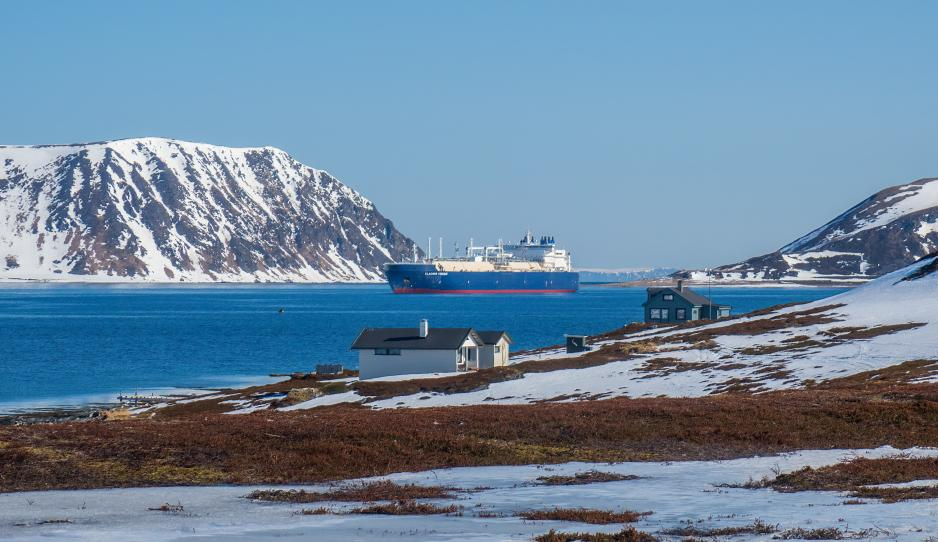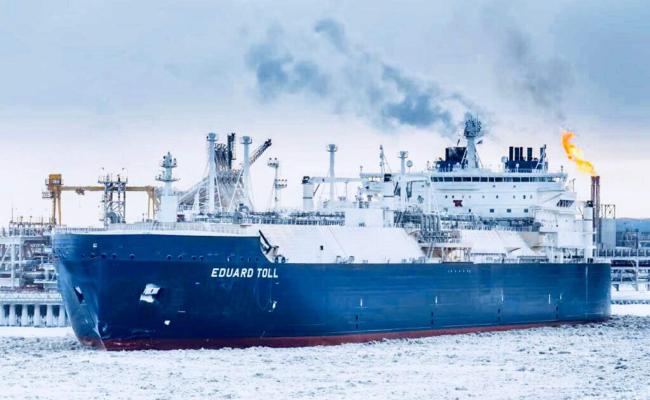Op-ed: Stop Russia’s Arctic LNG now: The G7 Must Shut Down the Tankers Financing Putin’s War

LNG carrier Vladimir Voronin off the coast of Honningsvåg in Northern Norway on 15 April 2023. (Source: Courtesy of Kjell-Bendik Pedersen)
This is an opinion piece written by an external contributor. All views expressed are the writer's own.
As COP30 concluded without a mention of fossil fuels in the official text, a less-noticed story emerged that addresses the critical gaps between climate and geopolitics with moral clarity and exposes the true face of the fossil fuel industry.
Ukrainians in Belem have hosted a panel discussion with a spotlight on the Russian strategic push to expand fossil fuel production (and greenhouse gas pollution) in the most sensitive region of the Earth - the Arctic.
The message could not have been clearer: Russia’s export of liquefied natural gas from the Arctic is the last major financial artery keeping Putin’s war machine alive — and the G7 must cut it now, before it expands to become a climate killer.
For the last three years, Russia’s fossil-fuel exports have remained the single largest source of revenue sustaining its aggression.
With pipeline gas to Europe collapsing, Moscow has pivoted to what it considers its most strategic, least-sanctioned asset: Arctic liquefied natural gas, shipped aboard a small fleet of specialised ice-class tankers that glide past sanctions regimes with impunity.
Russia’s Arctic LNG export is not simply a commercial venture
Yet this is not only a security threat. It is also a climate bomb — one that is destabilising the very region regulating the planet’s temperature.
The panel discussion that took place in Ukraine’s pavilion at COP30 laid out the evidence starkly.
Russia’s Arctic LNG export is not simply a commercial venture. It is a war-financing mechanism, a sanctions-evasion corridor, and a long-term dependency trap entangling Europe and Asia in contracts that stretch well into the 2030s and 2040s.
And it is accelerating warming at the fastest-changing place on Earth.
Blood money: How Arctic LNG finances Russia’s war
Between 2022 and 2024 alone, Yamal LNG is estimated to have paid $9.5 billion in taxes to the Kremlin. That is not metaphorical. It translates directly into missiles, drones, and artillery tearing through Ukrainian cities.
Also read (The text continues)
In fact, the Kremlin’s tax income from just six months of Yamal’s exports to Europe was enough to pay for the October 10 missile and drone barrage that plunged Kyiv into darkness and cut off water to hundreds of thousands of civilians.
Every LNG tanker departing from Russia is quite literally exporting the means of destruction. This is why we insist: Russian LNG is blood money — and governments enabling its flow must reckon with that truth.
Russia’s sanctions evasion superhighway
Many Western policymakers still assume Russia’s Arctic strategy has been crippled by sanctions. The reality is the opposite. Yamal LNG operates at full capacity, exporting over 17 million tonnes annually, almost entirely free of restrictions.
Specialised ARC7 icebreaking tankers — fourteen of the fifteen managed by Western companies from the UK, Greece, and Japan — provide the logistics backbone for these shipments. European ports, such as Zeebrugge and Dunkirk, remain indispensable hubs.
Not a gram of this Arctic gas could reach global markets without Western shipping, insurance, financing, and classification services. Maintenance and repairs of these ARC7 vessels depend on two European shipyards.
This crisis is not confined to today’s battlefield
Sanctioning pipeline gas while leaving this Arctic corridor open is like locking the front door but leaving the back door wide open.
Lock-in: Decades of dependence until 2041
This crisis is not confined to today’s battlefield.
With long-term purchase contracts stretching into the late 2030s and early 2040s — TotalEnergies (France), SEFE (Germany), Shell and others — European companies are entrenching future dependence on a regime waging the largest land war in Europe since 1945.
These deals are strategic, not merely commercial, and Moscow treats them as such.
Meanwhile, Russia plans to triple its LNG exports by 2035, with Arctic LNG-2 poised to join Yamal LNG once sanctions are lifted. The window to prevent this lock-in is closing fast.
Also read (the text continues)
A climate catastrophe in real time
The Arctic is warming four times faster than the global average. Fossil fuel expansion here is not just reckless — it is suicidal. New LNG infrastructure accelerates permafrost melt, methane release, and the opening of the Northern Sea Route for militarised energy shipments.
Russia is weaponising the region twice over: Once to finance war, and once to destabilise the global climate system.
No credible pathway to 1.5°C includes any new Arctic LNG capacity. The science is unambiguous: Arctic fossil fuel projects are incompatible with the Paris Agreement.
What the G7 must do now
The G7 possesses overwhelming leverage. Russia cannot operate Arctic LNG without Western ships, Western insurers, Western ports, Western shipyards, or Western financial services. That is precisely why decisive action now would work.
Sanctions work when they target dependencies
A credible G7 strategy must include:
A full embargo on Russian LNG and sanctions on all LNG tankers serving Russian projects: no imports, no bunkering, no port services, no maintenance, no vessel assistance.
Coordinated sanctions on Yamal LNG, Arctic LNG-2, Novatek and all subsidiaries.
A ban on European and allied companies operating ARC7 ice-class vessels.
Secondary sanctions on third-country buyers and traders.
Legal pathways to exit long-term contracts — now, not in 2041.
Sanctions work when they target dependencies. When the US sanctioned Arctic LNG-2, the project stalled. Apply that logic to Yamal, and Russia’s most profitable export stream collapses.
For Europe, the 19th sanctions package and REPowerEU already provide the legal tools. The EU’s upcoming Regulation banning Russian gas imports will make it illegal to continue existing term contracts without exposing European companies to legal penalties.
Clear EU guidance will help avoid legal disputes and ensure consistent application across member states.
Also read (the text continues)
This is the core political message the G7 must internalise: climate security and Ukrainian security are the same fight. The Arctic is where they intersect most directly. Every cargo of Russian LNG undermines both.
You cannot protect the climate while financing the largest fossil-fuelled war on Earth.
The question is no longer whether sanctions on Arctic LNG would work. They have already been applied effectively. The only question left is whether the G7 has the political courage to finish the job.
The ARC7 tankers must be stopped. The Arctic must be protected. And Ukraine must not continue to bleed for the sake of short-term profit and long-term fossil dependence.
The world is out of time — and out of excuses.





